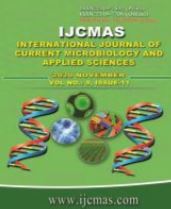


 National Academy of Agricultural Sciences (NAAS)
National Academy of Agricultural Sciences (NAAS)

|
PRINT ISSN : 2319-7692
Online ISSN : 2319-7706 Issues : 12 per year Publisher : Excellent Publishers Email : editorijcmas@gmail.com / submit@ijcmas.com Editor-in-chief: Dr.M.Prakash Index Copernicus ICV 2018: 95.39 NAAS RATING 2020: 5.38 |
300 patients were screened in ICUs of a tertiary care hospital in southern India to detect the rate of Hospital Acquired Infection (HAI) and antibiotic trends. Clinical samples received in the laboratory were processed as per CLSI (Clinical laboratory standard institute) guidelines. Patients were followed up to 72 hours post discharge. Markers of infection were noted and correlated with the findings in our laboratory. Kirby bauer antibiotic susceptibility test (ABST) was used for isolates with special reference to Extended Spectrum Beta lactamase (ESBL) production and Methicillin Resistant Staphylococcus aureus (MRSA). 10.7% were detected to have HAI during their stay in the ICU. Males above 30 years showed higher prevalence of HAI. Respiratory tract infection (RTI) was the commonest nosocomial infection detected in 56.3% of HAI cases, of which 19% were VAP (Ventilator Associated Pneumonia). Urinary tract infection (UTI) was 25% being the second commonest, followed by Blood stream infection (BSI) 12.5%. The most common organism isolated was Acinetobacter baumannii 33.4%, followed by Klebsiella pneumoniae 19.4%, & Escherichia coli (E. coli) 16.6%. 24.1% isolates were ESBL producers & 66.6% were MRSA. Gram positive organisms showed 100% resistance to Penicillin G & Erythromycin. However, Vancomycin, Linezolid, Tetracycline, Chloramphenicol, Teicoplanin & Tigecycline were sensitive. 74% of Gram-negative organisms were susceptible to Carbapenems & 2% were resistant to Polymyxin B and Colistin. The only effective way to control HAIs is to continuous monitoring of prevalence of infective organisms with their ABST.
 |
 |
 |
 |
 |